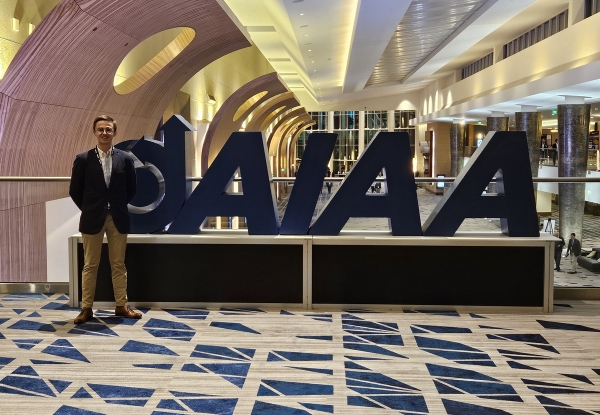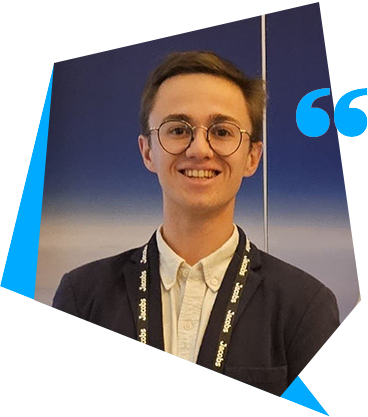< back to articles
Carmelo presents his work at AIAA 2024
Published on
From January 8 to 12, Carmelo Simon Soria headed for Orlando in the USA to present his research work at the AIAA SciTech Forum 2024: he was able to demonstrate the MDAO method used for the design of a hydrogen-powered aircraft.

Tell us about your project:
My Bachelor’s degree in Aerospace Engineering at Delft culminated in a group project lasting several weeks. Even after the official end of the project, I had the opportunity to continue developing it, with the aim of publishing it at the SciTech Forum 2024 conference.
I decided to seize this opportunity, and committed myself to writing an article about the methods we had used to design our aircraft. The aircraft is a hydrogen-powered, VTOL aircraft capable of carrying 4 passengers over a distance of 400km. The aircraft design methodology incorporated safety and crashworthiness considerations. In the conference paper presented at the SciTech 2024 conference in Orlando (USA), I had the pleasure and honor of presenting the CADD method used for this design. This method takes into account all the constraints given at the time of design, which come from spatial or physical constraints, or from design choices made via an informed compromise based on engineering judgment. Once the constraints have been defined, the method determines a feasible design space, characterized by all the variables introduced, and seeks the optimization of one or more variables within this space. The product is a design that satisfies the given constraints and is optimized for said variables. This publication was made in partnership with my colleagues at TU Delft.
Tell us about your experience at the conference:
Carmelo Simon Soria

My participation in the Orlando conference was an unparalleled experience. Not only did it give me the opportunity to show off my work to the audience, but I was also able to present myself as a young student to an audience of industry experts and leaders. The conference also gave me the opportunity to learn more about current events and the future of the aerospace field, to meet students, leaders, companies and, in general, people who will help me expand my network of connections, and guide me through their experiences to build my professional career.
The conference brought together :
- 6045 people
- 1000 companies and institutions
- 45 different countries.
The international scope of this conference is undeniable, and it was an honor to be able not only to attend, but also to participate. ISAE-SUPAERO’s presence at this event has made it an international player in the aerospace sector. As Pr. Lustosa points out in his letter of recommendation, this publication with TU Delft enables ISAE-SUPAERO to rank higher in international rankings, such as the Shanghai Ranking. Moreover, this work on a CADD product adds weight to ISAE-SUPAERO’s already existing international recognition and reputation in this field, following the success of the FAST-OAD project.
What do you take away from this experience on a personal level?
In light of everything I’ve learned, and all the people I’ve had the pleasure of meeting on this trip, I think I’ve made the most of this opportunity. At the conference, I was able to talk to design leaders from some of the industry’s most influential companies, astronauts and directors of various associations and programs, as well as a host of people who share a similar passion for innovation, and who are eagerly watching the future of the field approaching at high speed. All these discussions, each one more stimulating than the last, helped me to deepen my career ambitions in the field of control theory.
In particular, I was able to talk to JPL workers who have developed the EELS (Exobiology Extant Life Surveyor). This robot is destined to revolutionize interplanetary exploration, thanks to its ability to adapt to the environment. This robot, with 60 DoF, poses an extraordinary challenge from a control theory point of view: it enormously reduces the costs of interplanetary exploration, since it will reduce the total number of missions required to capture the necessary scientific information, and at the same time reduce the risk of loss during the mission thanks to its snake-like construction.
Similarly, and influenced by the large presence of companies in the defense sector, I deepened my passion and desire to train in this sector. World leaders in this field were present, including Lockheed Martin, RTX and Northrop Grumman, among others. Although my nationality prevents me from working for these companies directly, due to the political context, these discussions enabled me to define my ambition and find the motivation to develop a career in this field with competent European companies, such as Airbus Defence, or MBDA.
Any final words?
Thanks to the grant offered by the Fondation ISAE-SUPAERO, I was able to finance part of this trip, which had the merit of completely changing my perception of the aerospace sector. This trip was originally, unfortunately, out of my personal budget, due to the distance of the destination and the length of the conference. Going to Orlando for a whole week requires a substantial budget, which is not easily accessible. I am fully aware that this trip would have been financially difficult without the Foundation’s grant. For this reason, I would like to thank the ISAE-SUPAERO Foundation for its generous contribution, which enabled me to realize an adventure and a personal dream.
I had the opportunity to learn more about the current and future of the aerospace sector, while meeting current leaders in the field and learning how to direct my career towards a professional future in which I can exploit my knowledge and skills.
Thank you so much for showing me that effort is valued and for making me feel appreciated at this university.